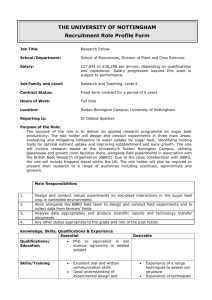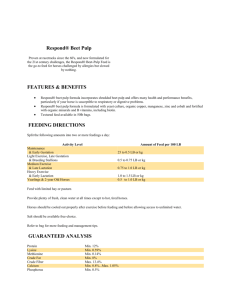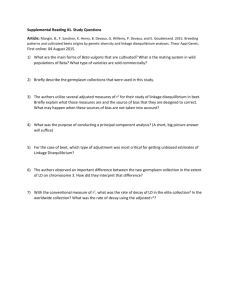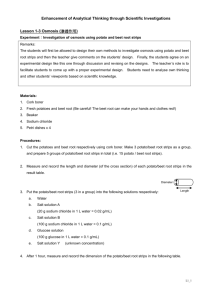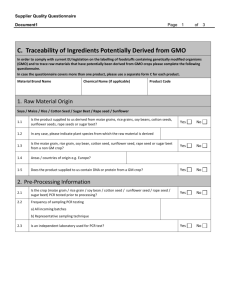Supplementary Table 1
advertisement
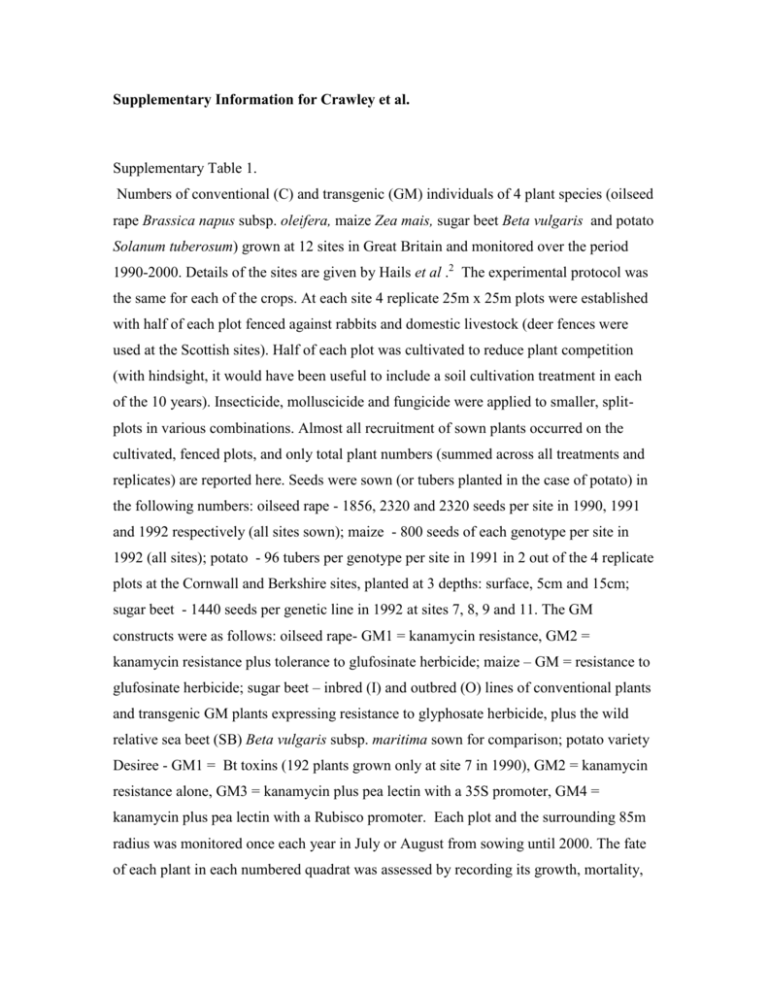
Supplementary Information for Crawley et al. Supplementary Table 1. Numbers of conventional (C) and transgenic (GM) individuals of 4 plant species (oilseed rape Brassica napus subsp. oleifera, maize Zea mais, sugar beet Beta vulgaris and potato Solanum tuberosum) grown at 12 sites in Great Britain and monitored over the period 1990-2000. Details of the sites are given by Hails et al .2 The experimental protocol was the same for each of the crops. At each site 4 replicate 25m x 25m plots were established with half of each plot fenced against rabbits and domestic livestock (deer fences were used at the Scottish sites). Half of each plot was cultivated to reduce plant competition (with hindsight, it would have been useful to include a soil cultivation treatment in each of the 10 years). Insecticide, molluscicide and fungicide were applied to smaller, splitplots in various combinations. Almost all recruitment of sown plants occurred on the cultivated, fenced plots, and only total plant numbers (summed across all treatments and replicates) are reported here. Seeds were sown (or tubers planted in the case of potato) in the following numbers: oilseed rape - 1856, 2320 and 2320 seeds per site in 1990, 1991 and 1992 respectively (all sites sown); maize - 800 seeds of each genotype per site in 1992 (all sites); potato - 96 tubers per genotype per site in 1991 in 2 out of the 4 replicate plots at the Cornwall and Berkshire sites, planted at 3 depths: surface, 5cm and 15cm; sugar beet - 1440 seeds per genetic line in 1992 at sites 7, 8, 9 and 11. The GM constructs were as follows: oilseed rape- GM1 = kanamycin resistance, GM2 = kanamycin resistance plus tolerance to glufosinate herbicide; maize – GM = resistance to glufosinate herbicide; sugar beet – inbred (I) and outbred (O) lines of conventional plants and transgenic GM plants expressing resistance to glyphosate herbicide, plus the wild relative sea beet (SB) Beta vulgaris subsp. maritima sown for comparison; potato variety Desiree - GM1 = Bt toxins (192 plants grown only at site 7 in 1990), GM2 = kanamycin resistance alone, GM3 = kanamycin plus pea lectin with a 35S promoter, GM4 = kanamycin plus pea lectin with a Rubisco promoter. Each plot and the surrounding 85m radius was monitored once each year in July or August from sowing until 2000. The fate of each plant in each numbered quadrat was assessed by recording its growth, mortality, flowering and seed set. Particular attention was paid to finding and monitoring recruits in the second and subsequent generations from seed produced by the sown plants. The performance of different genetic lines were compared by analysis of deviance (binomial tests) on the numbers of surviving individuals, calculated separately for each site, using plant numbers from the previous monitoring occasion as the binomial denominator for each test. * = conventional plants significantly out-performed GM plants (p < 0.01, chi square); + = GM plants significantly out-performed conventional plants; # = outbred plants significantly out-performed inbred plants (sugar beet only). These marks denote the significance of single-degree-of-freedom contrasts, comparing C and GM lines (they do not indicate which GM lines were different). In no case did any of these significant differences in short term survival map into significant differences in long term persistence. Only rape and sea beet produced any ripe seeds. For oilseed rape, fruits (mean = 6.54 sound seeds per fruit) were produced as follows: site 8 (3494, 1767, 2444 * fruits in total over 3 years by C, GM1 and GM2 lines respectively), site 10 (2756, 3306, 2050 n.s.), site 2 (2336, 2027, 1380 *), site 12 (233, 241, 142 n.s.), site 1 (134, 80, 281 n.s.), site 11 (4, 31, 8 n.s.), site 9 (2,5,5), site 5 (2, 0, 0), site 7 (1,0,0), but no seed ripened in any year at sites 4 or 6. None of this seed production led to the production of a subsequent generation of adult plants except at site 10, where 2 large self-sown plants were found in 1993 (these died and left no progeny in 1994). Seedlings of 2nd generation plants of maize, potato, sugar beet and sea beet were not observed at any of the sites. Seedlings of sea beet did establish on open ground at Silwood Park where potted plants had stood in 1992. Recruitment from dormant seed in the seed bank was not observed for any species at any site from 1994 onwards. Survival of perennial individuals for 2 or more years was noted for potato, sea beet and sugar beet. The last of the sea beet plants at Site 10 died in 1995-6. Although all sea beet plants sown on the Silwood sites died out within 2 years, a population of > 250 sea beet plants still persists on open ground at Silwood Park in August 2000. Potatoes still survive under bracken, Pteridium aquilinum at Site 6 in Silwood Park in 2000.
